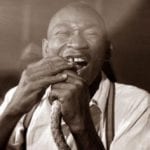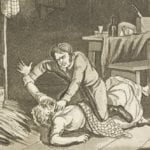 Creepy
Creepy  Creepy
Creepy  Movies and TV
Movies and TV 10 Movies That Get Elite Jobs Right, According to Experts
 Weird Stuff
Weird Stuff 10 Times Real Laws Were Based on Bizarre Hypotheticals
 Animals
Animals 10 Inspiring Tales of Horses Being Human
 Mysteries
Mysteries Top 10 Haunting Facts About the Ghost Ship MV Alta
 History
History 10 Surprising Stories About the Texas Rangers
 Humans
Humans 10 Philosophers Who Were Driven Mad by Their Own Theories
 Miscellaneous
Miscellaneous 10 Video-Game-Worthy Weapons and Armors from History
 Weird Stuff
Weird Stuff 10 Psychics Who Accurately Predicted Wartime Events
 The Arts
The Arts 10 Pieces of Art Inspired by a Broken Heart
 Creepy
Creepy 10 Death Superstitions That Will Give You the Creeps
 Movies and TV
Movies and TV 10 Movies That Get Elite Jobs Right, According to Experts
 Weird Stuff
Weird Stuff 10 Times Real Laws Were Based on Bizarre Hypotheticals
Who's Behind Listverse?

Jamie Frater
Head Editor
Jamie founded Listverse due to an insatiable desire to share fascinating, obscure, and bizarre facts. He has been a guest speaker on numerous national radio and television stations and is a five time published author.
More About Us Animals
Animals 10 Inspiring Tales of Horses Being Human
 Mysteries
Mysteries Top 10 Haunting Facts About the Ghost Ship MV Alta
 History
History 10 Surprising Stories About the Texas Rangers
 Humans
Humans 10 Philosophers Who Were Driven Mad by Their Own Theories
 Miscellaneous
Miscellaneous 10 Video-Game-Worthy Weapons and Armors from History
 Weird Stuff
Weird Stuff 10 Psychics Who Accurately Predicted Wartime Events
 The Arts
The Arts 10 Pieces of Art Inspired by a Broken Heart
10 Twisted Ways That People Used To Be Entertained
There you are, playing your favorite video game when Grandpa walks in. You know you’re going to get an earful of rant when your avatar rips this chainsaw through the other player.
Don’t worry, my friend. Here is a handy list of some of the most twisted and macabre ways that humans entertained themselves in eras well before Grandpa was even on the Earth. You know, to throw back his way when that rant begins.
10 True Crime

Some of the earliest celebrities were criminals. People would follow the stories of the crimes and the searches for outlaws, murderers, and bank robbers. They would pore over every small detail and hope to see a bloody recreation or photo of the crime scene.
Pat Garrett, the man who brought down Billy the Kid, even had to write and publish his own account of what happened after the outcry of people who bought up the 15 dime novels that were published about this Old West outlaw. Garrett had to remind people that Billy was a thief and a murderer.[1]
The ambush site of Bonnie and Clyde became a chaotic circus of true crime fanatics when the couple was killed. One woman got away with locks of Bonnie’s hair to sell later, while another man was chased away for trying to cut off Clyde’s trigger finger.
The coroner overseeing the site said:
Nearly everyone had begun collecting souvenirs such as shell casings, slivers of glass from the shattered car windows, and bloody pieces of clothing from the garments of Bonnie and Clyde. One eager man had opened his pocket knife and was reaching into the car to cut off Clyde’s left ear.
Compared to that, listening to a podcast doesn’t sound so bad.
9 Le Grand Guignol
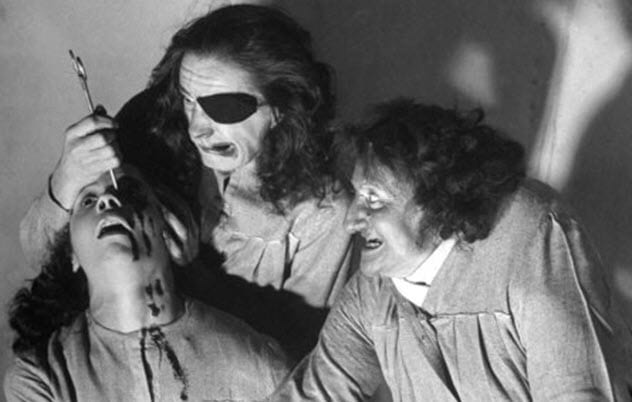
In 1897, Oscar Metenier opened his theater, Le Grand Guignol. While the theater was considered controversial for employing prostitutes, criminals, and other dregs of society, Metenier and his partner, Andre Antoine, told the authorities to hold their beers. The Guignol became famous for ramping up the controversy by adding scenes of extreme violence and gore into their plays.
Plays like Le Laboratoire des Hallucinations and Le Baiser dans la Nuit drew in crowds averaging 250, including celebrities and royalty, with their scenes of bloody horror, dismemberment, and perversion.
One play involved a doctor who finds the man that’s sleeping with his wife on his operating table. Another play dealt with how a man gets revenge on the woman who disfigured him with acid.[2]
The Guignol’s scenes didn’t shy away, either! One famous scene showed a man strangling a woman to death before cutting her arm off, only to discover that she wasn’t truly dead yet. All this in full view of the audience.
The Guignol continued shows until 1962 when the audience diminished and it was forced to close. While the director at the time blamed World War II, many people placed blame on his decision to cut back on the gore.
8 Dark Rides

If you look up “dark rides” today, you’ll get a list of fairly tame themed rides centered around cartoon mice, innovative technology, and carnival fun. If you dig just a little deeper, though, you’ll see the era when horror ruled these rides.
Step outside the major parks and head down to the state fairs and carnivals to see that more than half of these dark rides have themes that deal with mad doctors, demonic entities, ghost houses, dragons, and many other creepy monsters and madmen.
The Pretzel Amusement Ride Company became famous toward the end of the 19th century for making tracks for dark rides. Although the company made the track, it was up to their customer to create the theme of the ride.
Most carnival owners found that rides that could give the rider a good scare really drew in the dollars. This ramped up during the 1970s and 1980s when slasher films and horror movies were at the peak of popularity. They had become so popular that famed artist H.R. Giger owned and designed a dark ride for his personal use.
Dark rides are still in use today and have a massive fan base that is pulling for the preservation of these rides. Because we should all, at least once in our lives, ride a rickety cart into a dark room run by carnies.[3]
7 Slum Tourism
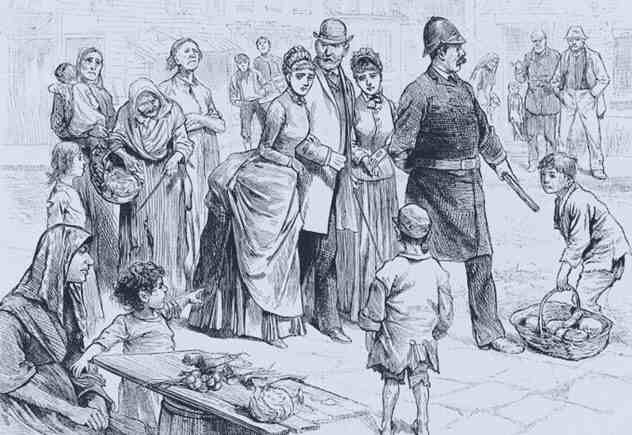
Do you ever think to yourself, “Man, I really need to put my millions of dollars, posh house, and hundreds of sports cars into perspective?” No? Neither do we. Apparently, people with these things do have that thought run through their minds on occasion. Just ask the people who work in the slum tourism industry.
In 1884, a trend began where the rich were willing to pay high dollars to take guided tours of poor areas of cities. Towns like White Chapel in London, Five Points in Manhattan, and Mumbai in India became very popular spots to take these tours.
While it was sold to the public as a means of showing the upper class how badly the lower class needed help, it soon became apparent that it was nothing more than a chance for the rich to scratch an itch for the morbid.
Surely, this isn’t something that still happens today. Well . . . about that. Even though people are fighting hard against this industry, you can still book tours of areas like Mumbai, Dharavi, Charleroi, South Central LA, 8 Mile, Belfast, South Africa, The Bronx, and most disaster areas.[4]
Kennedy Odede from Kenya once wrote in a New York Times op-ed: “They get photos; we lose a piece of our dignity.” Indeed.
6 Dime Museums
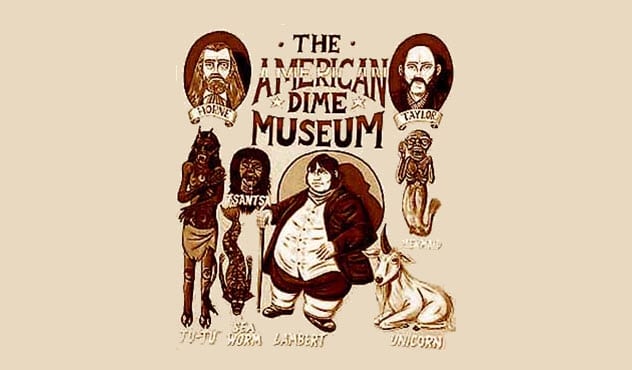
While originally billed as “edutainment to help the working class to understand the world around them,” dime museums were actually the chance for the lower classes to afford a bit of dark entertainment. While museums for the upper middle class were what you think of when you hear of a museum today, dime museums were essentially carnival sideshows that stayed in one centralized location as opposed to traveling.
At dime museums, you could see freak shows, “Fee Gee mermaids,” and other mounted displays. Their vaudeville acts helped to start the careers of Harry Houdini, Maggie Cline, and others.
While the popularity of dime museums reached their peak around the turn of the century, many still exist across the US. These include the International Cryptozoology Museum in Portland, Maine, the Museum of Death in Los Angeles, and the Monroe Moosnick Museum in Lexington, Kentucky.[5]
5 Cemetery Picnics
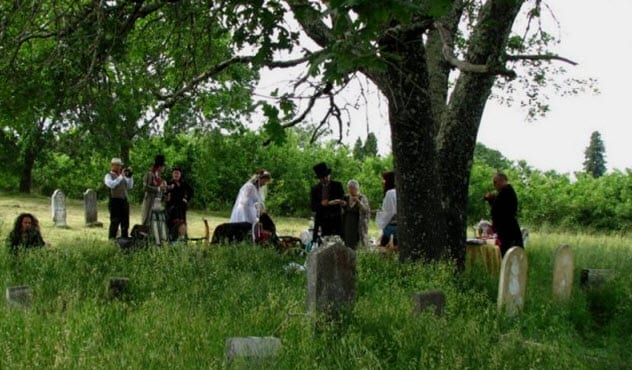
While everything else on this list can be seen as a glorious obsession with morbidity and death, cemetery picnics can actually be seen as the most wholesome and cheerful of the lot.
As we’ve seen before, the beginning of the 19th century was a time when people were desperate to get out and do anything to break the mundanity of daily life. Going to tend to grandma’s final resting place would do just that. Why not make a day of it?
At the time, cemeteries were beautiful areas of town that were well maintained. Considering that public parks weren’t a thing yet and human mortality was closer to the front of the mind than it is now, cemeteries were the places to enjoy the outside while you were still alive.[6]
A lot of cemeteries actually have rules against having picnics because of the solemn nature of graveyards now.
4 Asylum Tourism
While it could be lumped into the same category as the slum tourism that was mentioned earlier, asylum tourism actually evolved to be a bit more of a positive thing.
In the 1800s, it was common for tourism pamphlets to make mention of seeing the local asylum. These tours originally were intended to take advantage of the public’s need to see the darker side of the world.
By the 1900s, however, they were more a display of the evolution of medical and mental treatments. The stops on the tour were no longer about simply gawking at the insane and the debilitated. Instead, they started showing the steps that the hospitals were taking to cure their patients.
Some facilities discouraged the tours as an excuse for the public to come and see the insane or even as a distraction for the nursing staff from their regular duties. Others insisted on the tours as a way to show the public the reality of mental illness, educate people in the methods of treatment, try to end the stigmas that came with mental illness, and gain the confidence of the public in the hospital.[7]
3 Witch Hunts

Witch hunts have been around since humanity has needed to blame the ills of the world on anything at all. While witchcraft was seen as just another death-worthy offense through the Middle Ages, witch trials didn’t become an exclusive form of dark entertainment until the 16th century.
With the fear of disease and misfortune, the competition between the Protestant Church and the Catholic Church to gain followers, and the rising tide of “witch hunters” such as Matthew Hopkins, witch trials soon began drawing the curiosity of the public.
Hopkins and his lot found a means of making a good living by going from town to town, whipping the fear of the unknown into a frenzy, and then making a massive spectacle of the trials of people who were simply scapegoats. Not long after, the American colonies began to have their own witch hunts that drew entire towns to the courthouse to witness these spectacles.[8]
People would gather under the excuse of “civic duty” to see the accused cast spells and the witnesses writhe in faux agony. There was even a small possibility of glimpsing some skin while they were looking for the “devil’s mark.”
It was truly a manic circus that had to be seen to be believed. Thousands of innocent individuals died during the 16th and 17th centuries simply because other people were bored and scared.
2 Dogfighting
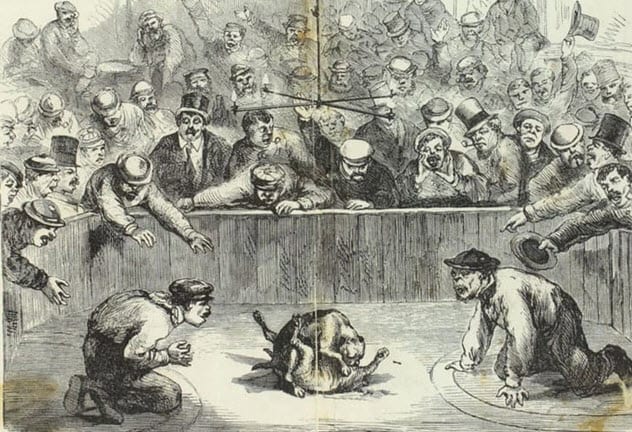
Dogfighting can be traced back to the Roman invasion of Britain. When the Romans saw just how vicious Britain’s war dogs could be, they began importing the animals for use in betting events.
In the 12th century, baiting became a regular form of entertainment for nobility in England. Baiting is when a dog is released on a larger animal that may be tied or chained to the floor. Dog fighting, rooster fighting, and other animal fight “sports” had become a worldwide phenomenon.
By the 1860s, most states in the US had outlawed dogfighting once it was recognized as the inhumane act that it is. Other regions of the world started to enact laws against dogfighting soon after.[9]
Still, dogfighting is a major problem worldwide. Some nations—such as Afghanistan, Pakistan, Russia, China, Albania, and many prefectures of Japan—even allow dogfighting as a form of entertainment. Even the countries that have banned dog and animal fighting have to stage regular raids to arrest dogfight promoters and patrons.
1 Public Executions
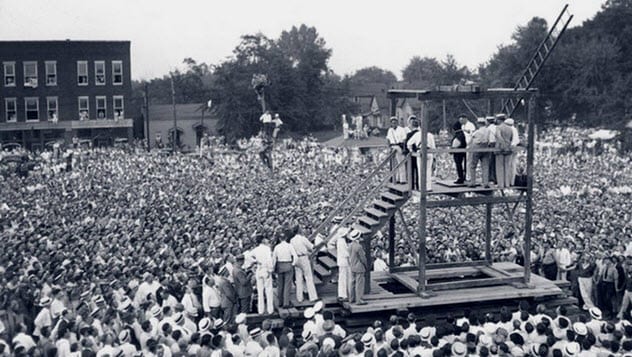
It’s difficult to establish the beginning of public executions, but it’s a widely held belief that they started as a means of showing governmental control over their people. It wound up becoming an almost carnival-like environment.[10]
In Severed: A History of Heads Lost and Heads Found, author Frances Larson said:
For as long as there were public executions, there were crowds to see them. In London in the early 19th century, there might have been 5,000 to watch a standard hanging, but crowds of up to 100,000 came to see a famous felon killed. The numbers hardly changed over the years. An estimated 20,000 watched Rainey Bethea hang in 1936, in what turned out to be the last public execution in the US.
People would gather in the town square to hear the condemned speak their last words, buy a snack from a vendor, laugh at the sideshows, and just enjoy the spectacle of gathering together to watch someone die.
While most nations have shied away from the practice, many countries staged public executions as late as 2012, according to Amnesty International. The final public execution in France was in 1939.
Serial killer Eugen Weidmann was executed by guillotine in front of several hundred spectators, including a 17-year-old Christopher Lee. The governor had decided that this would be the last public execution because of the throngs of people who mobbed the scene to get souvenirs.
Lee Drake is a writer and 3-D artist who currently lives in Orlando, Florida. He also hosts a vlog on horror, haunted attractions, and other scary things over on Youtube.
Read about more twisted ways that people used to be entertained on 10 Bizarre Entertainments Of Victorian London and 10 Offensive Things That Once Passed For Entertainment.


